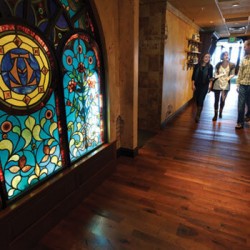Facing the Future
The statue atop Wisconsin’s capitol was supposed to look “Forward.” But what direction is that?

In 1914, the Wisconsin State Journal surveyed readers about which way the statue should face. Sam Li
Wisconsin — the gilded goddess that peers down from the top of the state capitol — is one of Madison’s longest-standing (and tallest) residents. But upon the arrival of the statue created by American sculptor Daniel Chester French in 1914, the question of which direction she would face was the subject of great public debate.
West-siders argued that Wisconsin’s eyes should remain fixed on the university. Civil War veterans advocated for a western view of Camp Randall in honor of the “ten thousand Badger boys that died for the old flag.” Others cited the legacy of western expansion, given the sculpture’s embodiment of the state’s motto, “Forward.”
East-siders weren’t so easily convinced. Many suggested that figures on state capitols should face Washington, DC. Even more posited that “Forward” indicated the direction of daybreak. “Since earliest history, the rising sun has been symbolic of a new day, progress, enlightenment, advancement,” one voter wrote in response to a naming contest facilitated by the Wisconsin State Journal, which published daily returns on the heated race.
For several days, King Street (east) and State Street (west) were considered the only viable contenders, but two-block-long Monona Avenue (now Martin Luther King Jr. Boulevard, to the southeast) garnered widespread support amid talk of a park between the capitol and Lake Monona.
A true underdog, Monona Avenue ultimately made up for what it lacked in both blocks and ballots, thanks in large part to the capitol’s architecture. While the building’s four wings point toward the cardinal directions, the four small rotundas nestled between them were considered its formal entrances. Facing the statue toward Monona Avenue designated it as the official entryway to the capitol and ensured her watch over an imagined “future plaza which will lead from the capitol to the water gate of the city.”
Wisconsin made her ascent to the top of the capitol dome on July 20, 1914. Her arms have since reached out to every dawn and over a street that now honors a civil rights giant whose dream of the future reverberates throughout our country.
“European cities have been made beautiful because their builders had the vision to see their cities in the future,” the State Journal ballot read. “Think ahead. How would you face ‘Forward’?”
Published in the Spring 2023 issue



Comments
No comments posted yet.